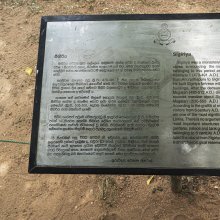Kaleya, Kāleya, Kalehugida: 13 definitions
Introduction:
Kaleya means something in Hinduism, Sanskrit, Jainism, Prakrit. If you want to know the exact meaning, history, etymology or English translation of this term then check out the descriptions on this page. Add your comment or reference to a book if you want to contribute to this summary article.
Images (photo gallery)
In Hinduism
Purana and Itihasa (epic history)
Source: archive.org: Puranic EncyclopediaKāleya (कालेय).—A set of Asuras born to the great sage Kaśyapa of his wife Kālā. Some scholars hold the view that the Kālakeyas and the Kāleyas are one and the same. Kāleyas destroyed the Āśramas of sages like Vasiṣṭha, Cyavana and Bharadvāja. (Vana Parva, Chapter 102). Devas killed some of the Kāleyas; the others ran away to Pātāla.
Source: Cologne Digital Sanskrit Dictionaries: The Purana Index1a) Kāleya (कालेय).—An Asura who was exhausted in Amṛtamanthana.*
- * Bhāgavata-purāṇa VIII. 7. 14.
1b) An Ātreya, putrikā putra.*
- * Matsya-purāṇa 197. 9.
1c) Dānavas and Nāgas in Rasātala. These took part in Devāsura war between Bali and Indra. They fought with Vasus.*
- * Bhāgavata-purāṇa V. 24. 30; VIII. 10. 22 and 34.
Kāleya (कालेय) is a name mentioned in the Mahābhārata (cf. I.59.34, I.65, I.61.46) and represents one of the many proper names used for people and places. Note: The Mahābhārata (mentioning Kāleya) is a Sanskrit epic poem consisting of 100,000 ślokas (metrical verses) and is over 2000 years old.

The Purana (पुराण, purāṇas) refers to Sanskrit literature preserving ancient India’s vast cultural history, including historical legends, religious ceremonies, various arts and sciences. The eighteen mahapuranas total over 400,000 shlokas (metrical couplets) and date to at least several centuries BCE.
Languages of India and abroad
Sanskrit dictionary
Source: DDSA: The practical Sanskrit-English dictionaryKāleya (कालेय).—a. Belonging to the Kali age.
-yam 1 The liver.
2) Black sandal-wood; आश्यानकालेयकृताङ्गरागाम् (āśyānakāleyakṛtāṅgarāgām) Kumārasambhava 7.9.
3) Saffron.
-yāḥ (-m. pl.) Name of a school of the black Yajurveda.
Source: Cologne Digital Sanskrit Dictionaries: Shabda-Sagara Sanskrit-English DictionaryKāleya (कालेय).—mfn.
(-yaḥ-yī-yaṃ) 1. Belonging to the Kali age, &c. 2. Dark coloured. n.
(-yaṃ) 1. A yellow fragrant wood: see kālīyaka and kāleyaka. 2. The liver. m.
(-yaḥ) The name of a demon or imp. E. kāla or kali, and ḍhak affix.
Source: Cologne Digital Sanskrit Dictionaries: Benfey Sanskrit-English DictionaryKāleya (कालेय).—i. e. 2. kāla + eya, I. n. A dark kind of sandal, [Kumārasaṃbhava, (ed. Stenzler.)] 7, 9. Ii. m. The name of a tribe of Daityas, Mahābhārata 3, 8719; 8769.
Source: Cologne Digital Sanskrit Dictionaries: Monier-Williams Sanskrit-English Dictionary1) Kāleya (कालेय):—[from kāla] 1. kāleya n. ([from] 1. kāla), the liver, [cf. Lexicographers, esp. such as amarasiṃha, halāyudha, hemacandra, etc.]
2) [v.s. ...] a yellow fragrant wood, [Kumāra-sambhava vii, 9]
3) [v.s. ...] saffron, [cf. Lexicographers, esp. such as amarasiṃha, halāyudha, hemacandra, etc.]
4) [v.s. ...] 2. kāleya n. (metron. [from] kālā), Name of a Nāga (= Kāliya), [cf. Lexicographers, esp. such as amarasiṃha, halāyudha, hemacandra, etc.]
5) [v.s. ...] m. [plural] Name of a family of Daityas, [Mahābhārata iii; Bhāgavata-purāṇa]
6) 3. kāleya n. ([from] 1. kali [see sub voce kali] [Pāṇini 4-2, 8]), the Sāman of Kali, [Śāṅkhāyana-śrauta-sūtra; Ārṣeya-brāhmaṇa; Lāṭyāyana]
7) m. [plural] Name of a school of the black Yajur-veda
8) mfn. belonging to Kali or the Kali age, etc., [Pāṇini 4-2, 8; Patañjali]
Source: Cologne Digital Sanskrit Dictionaries: Yates Sanskrit-English DictionaryKāleya (कालेय):—[(yaḥ-yā-yaṃ) a.] Of time; dark. m. A demon. n. A fragrant wood; the liver.
Source: DDSA: Paia-sadda-mahannavo; a comprehensive Prakrit Hindi dictionary (S)Kāleya (कालेय) in the Sanskrit language is related to the Prakrit words: Kālija, Kāleya.
[Sanskrit to German]
Sanskrit, also spelled संस्कृतम् (saṃskṛtam), is an ancient language of India commonly seen as the grandmother of the Indo-European language family (even English!). Closely allied with Prakrit and Pali, Sanskrit is more exhaustive in both grammar and terms and has the most extensive collection of literature in the world, greatly surpassing its sister-languages Greek and Latin.
Prakrit-English dictionary
Source: DDSA: Paia-sadda-mahannavo; a comprehensive Prakrit Hindi dictionaryKāleya (कालेय) in the Prakrit language is related to the Sanskrit word: Kāleya.
Prakrit is an ancient language closely associated with both Pali and Sanskrit. Jain literature is often composed in this language or sub-dialects, such as the Agamas and their commentaries which are written in Ardhamagadhi and Maharashtri Prakrit. The earliest extant texts can be dated to as early as the 4th century BCE although core portions might be older.
Kannada-English dictionary
Source: Alar: Kannada-English corpusKālēya (ಕಾಲೇಯ):—
1) [noun] the perennial plant Crocus sativus of Iridaceae family with funnel-shaped, purplish flowers having orange stigmas; saffron plant.
2) [noun] the dried, aromatic stigmas of this plant, used in flavouring and colouring foods; saffron.
3) [noun] a red pigment , applied by women on their forehead, as a sign of auspiciousness; vermilion.
4) [noun] that which is related to Kaliyuga, fourth of the four mythological ages, which is current now, having a duration of 4,32,000 years.
--- OR ---
Kāḷehūgiḍa (ಕಾಳೆಹೂಗಿಡ):—[noun] the flowering plant Canna indica of Cannaceae family; Indian shot.
--- OR ---
Kāḷēya (ಕಾಳೇಯ):—
1) [noun] the perennial plant Crocus sativus of Iridaceae family with funnel-shaped, purplish flowers having orange stigmas; saffron plant.
2) [noun] the dried, aromatic stigmas of this plant, used in flavouring and colouring foods; saffron.
3) [noun] a red pigment , applied by women on their forehead, as a sign of auspiciousness; vermilion.
4) [noun] that which is related to Kaliyuga, fourth of the four mythological ages, which is current now, having a duration of 4,32,000 years.
Kannada is a Dravidian language (as opposed to the Indo-European language family) mainly spoken in the southwestern region of India.
See also (Relevant definitions)
Starts with: Kaleyaka, Kaleyakam, Kaleyakutuhala, Kaleyakutuhalaprahasana, Kaleyam, Kaleyamaram, Kaleyaru, Kaleyavairin, Kaleyayuga.
Ends with: Kshullakakaleya, Mahakaleya, Varkaleya.
Full-text: Kaleyayuga, Kaleyaka, Kalekavannam, Kalija, Kshullakakaleya, Kalakeya, Kaliyaka, Samudrasena, Kaleyam, Kalakanja, Brihatta, Kaliya, Rasatala, Dhak, Sya, Agasti, Vasu, Kala, Abhisheka.
Relevant text
Search found 16 books and stories containing Kaleya, Kāleya, Kalehugida, Kālēya, Kāḷehūgiḍa, Kāḷēya; (plurals include: Kaleyas, Kāleyas, Kalehugidas, Kālēyas, Kāḷehūgiḍas, Kāḷēyas). You can also click to the full overview containing English textual excerpts. Below are direct links for the most relevant articles:
The Skanda Purana (by G. V. Tagare)
Chapter 35 - Installation of Citreśvara Pītha < [Section 1 - Tīrtha-māhātmya]
Chapter 34 - Fight between Devas and Asuras < [Section 1 - Tīrtha-māhātmya]
Chapter 347 - Greatness of Hāṭakeśvara (Hāṭaka-īśvara) < [Section 1 - Prabhāsa-kṣetra-māhātmya]
The Padma Purana (by N.A. Deshpande)
Chapter 66 - The Slaying of Kāleya < [Section 1 - Sṛṣṭi-khaṇḍa (section on creation)]
Chapter 19 - Conversation of the Seven Sages < [Section 1 - Sṛṣṭi-khaṇḍa (section on creation)]
Historical Elements in the Matsya Purana (by Chaitali Kadia)
Lineages of Atri < [Chapter 6 - Human history in the Matsya-Purāṇa]
Manusmriti with the Commentary of Medhatithi (by Ganganatha Jha)
Verse 3.266 < [Section XXI - Relative Merits of the Offering-Materials]
Verse 3.101 < [Section VII - Duties of the Householder]
List of Mahabharata people and places (by Laxman Burdak)
The Bhagavata Purana (by G. V. Tagare)
Chapter 10 - A Battle between Gods and Asuras < [Book 8 - Eighth Skandha]
Chapter 24 - Rāhu’s Position and the Subterranean Regions < [Book 5 - Fifth Skandha]
Chapter 7 - The Churning of the Sea for Nectar < [Book 8 - Eighth Skandha]


